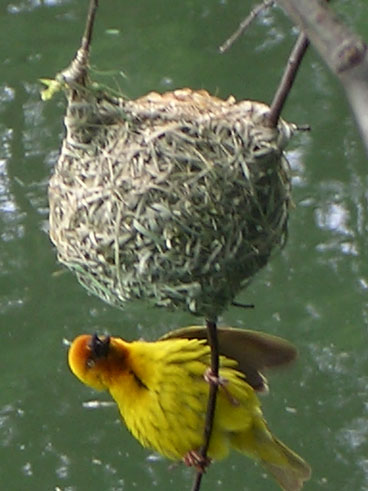
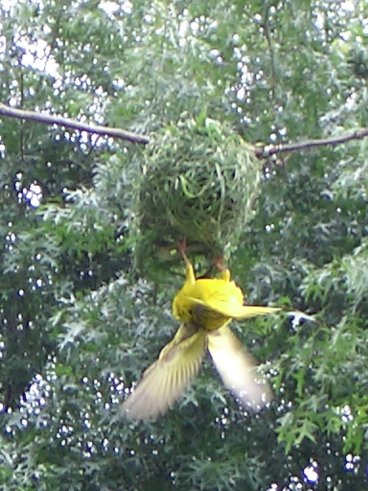
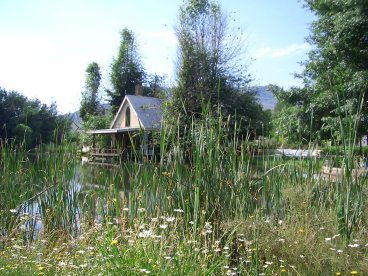
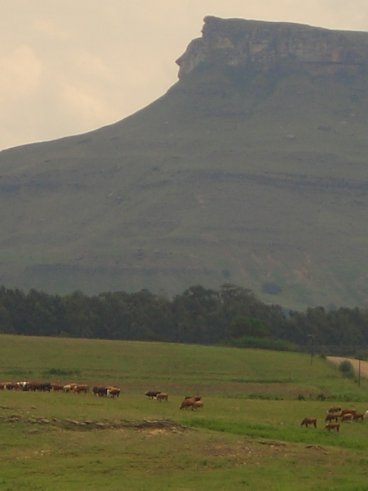
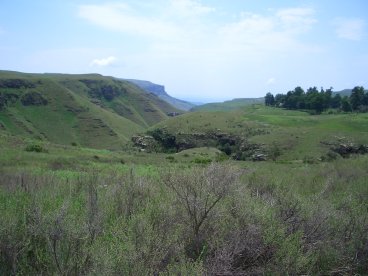
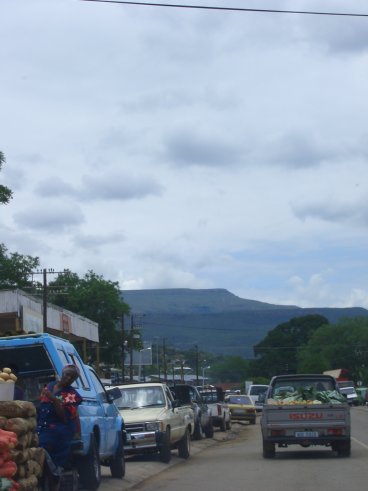
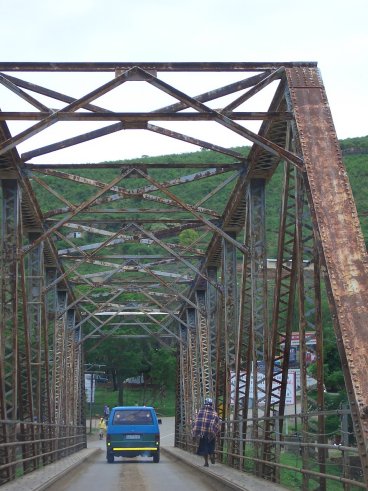
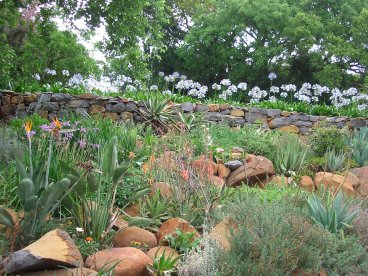
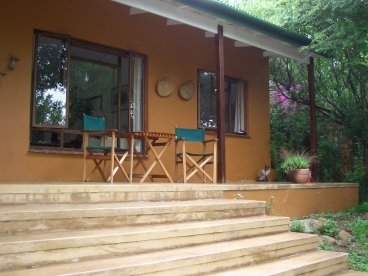
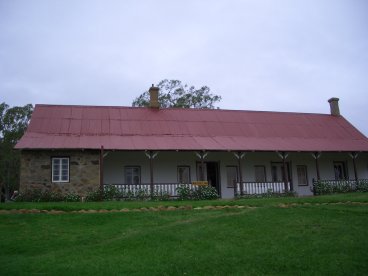
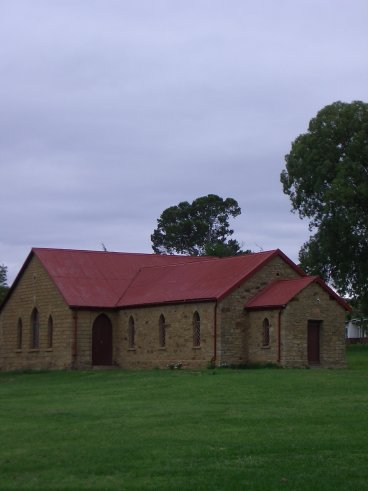











South Africa
Saturday 4 December 2004
Sitting by a glassy lake, wrapped by the Drakensberg Mountains, in Kwazulu Natal, snuggling up next to Lesotho, we’ve almost forgotten the sleepless flight from London. South African Airlines had sounded an attractive option and indeed the flight was on time and the staff fine enough. It was just the seat pitch - even less than normal! The seats were so close together my knees were sticking into the back of the seat in front. The person sitting there complained to the cabin crew! I said I was sorry but what do you want me to do, chop off my legs above the knees?
It was so uncomfortable that I could not sleep. Then a square jawed South African guy in the row behind got very drunk and loud and started arguing with his wife. When the cabin crew refused to serve him any more alcohol he got very aggressive , saying he would fight them, with comments like "I’ll put you all to sleep", which is a South African threat of a seriousness which varies from knocking someone out to killing them. He was warned but still kept on being very threatening. If he tried to duke it out in the confines of a Jumbo it would be dangerous for those nearby. The crew also knew that would be a bad idea and just left him. Eventually he went to sleep. But when he woke up at breakfast he demanded a drink again and was still aggressive, saying he paid their wages so why can’t he get a drink! When we landed the pilot asked everyone to wait in their seats as a passenger who had caused disruption would be "escorted" off the plane. A little black policeman came, arrested him and dragged him off. Good he deserved it. People get jail terms for that sort of behaviour on planes these days!
We landed at Jo’burg and headed straight onto another flight to Durban where we picked up a car - a VW Jetta/Passant type variant - and headed up for the very beautiful Drakensberg Mountains. We both wanted to fall asleep on the drive! But I was driving and so concentrated very hard to stay awake. We got higher - in places five to seven thousand feet up. Then you swoop down into green valleys. It was an area called The Midlands Meander, probably because it was like the middle of Scotland, the middle of England - the Derbyshire and Staffordshire Peak districts and the middle of Wales including Snowdonia all rolled into one. We stopped at the Sherwood Shopping Centre (in Nottingham Road of course) and bought lots of home made fudge to sugar ourselves awake.Then we turned into the Kamberg Valley and two and half hours after we had left Durban and 15 hours after we left London we were turning into Cleopatra’s Mountain Farmhouse.
It felt much as we had imagined only a bit more thanks to the impressive green velvet Drakensberg hills that surrounded it. The gardens dripped with rain left from the dramatic thunder storm we had spotted as we were driving in. Cleopatra's was a low slung farmhouse and cottages around a small lake; beautiful and practical gardens; and the obligatory large, friendly dogs (Treacle and Sienna). After a drink we collapsed in our garden-themed cottage and slept the sleep of the unjust.
We woke up at 5pm surprisingly refreshed apart from my SAA-damaged right knee. After a shower we joined, with some trepidation, the ‘dinner experience’.
Now Cleopatra’s was billed as a ‘gourmet delight’ serving five-course dinners that were ‘much discussed’. This was dangerous territory. If things did not go well we could find ourselves trapped in a paradise of pretention also as I rarely ate a three course meal. But we were in luck; Cleopatra’s was a genuine find, unpretentious and caring about detail – but the right kind of detail. The chef and owner was Richard Poynton and every evening he would come out and talk about Cleopatra’s, the area, and the food he was serving us for dinner - how it was cooked and which farm down the road the ingredients came from. It was top quality restaurant food. I've never eaten at one of those Michelin Star restaurants so this was an eye opener. Some of it was fantastic; other parts were way too rich with too much cream reduction. The quality of the ingredients and the quality of the cooking were incredible given there was just Richard and his female helper of twenty years in the kitchen.
That first evening at the pre-dinner drinks gathering we were definitely the ‘new people’. We sat on the deck and watched the bright yellow weaver birds bring bright green strands of grass to make their fantastic ball-shaped nests.The non-feathered crew were made up of two American couples, elderly (bush babies, I would guess); one South African couple, young; one English couple, young; and the A Team – a group of about eight women with a black guide/driver – South Africans on some kind of team-building event.
Up went the blackboard – the menu daunting in length – featuring Angus beef as the main event. Ingredients and cooking method were discussed by
Richard who was a real showman, able to put everyone at their ease, running not only through the menu but also the history of the farmhouse. The name Cleopatra comes from the next-door mountain; so called because her queenly profile appears to be carved on the side of it. He also included info on excursions and a plug for his cookbook. We went down to the cellar to choose our wine and then back up the stairs to the dining room, each party at separate tables and – it was great! We ate all five courses. They were small and not over-egged, just simple and delicious.
Not everyone stayed the course – the two American women retired hurt after the third course. Their husbands lingered on through to the port. During dinner we watched the lake as mist swirled across it. Kim expected swans and a wicked magician to swoop down. As the evening wore on the weaver birds were replaced with croaking tree frogs that rose to a handsome crescendo over dinner. We were in bed by 10.15 with stomachs that were a bit too full.
Monday 6 December
We had a full monty sleep and woke up early with the sun and the first shift of the birds outside. As breakfast wasn’t until 9.30 we got up and got taken for a walk by Treacle the Alsatian, past the lake and the landscaped gardens and through the wild meadow, down to the river, crossing the stream on the kiggley stones. This was peaceful, sparkly morning stuff.
We were starving by 9.30 am but not starving enough for Cleopatra's breakfast which was the only thing here that seemed a little over the top. This first morning we were faced with some kind of eggs Benedict - a poached egg sitting on a bed of bubble and squeak on a pressed round mushroom thing and scattered around were small chunks of fatty bacon. We’d have been happy with the fresh bread, fruit and homemade yoghurt but we staggered through and decided we should go up to Highmoor to walk some of it off.
“Watch out for the clouds, there’s meant to be a major thunderstorm and floods coming our way.” We were warned three times so we took this seriously. More people die from lightning strikes than snakebites in the Drakensbergs.We drove up to Highmoor which was a fantastic twenty minutes through amazing rock formations. Up and up and then eventually we reached the gatehouse to the nature reserve and rest camp. We parked up and it seemed pretty deserted. In the wooden office the old black guy seemed to make no sense of our question:
“What is the weather like? Is it safe to go out?” “Forty rand” he said carefully and thoughtfully. He seemed puzzled when we asked for a map but dug one out for us. “Thirty rand” he said gently.
We set off past the breeze block rest camp dormitories. Past two workers who looked at us then greeted us cheerfully when we waved. Then we were off along a little track that quickly turned from tarmac to dirt and then to rock. We crossed a wooden-slatted footbridge across the river then up a stony screed to the top of the ridge. And there we were – two isolated humans in the highest point on the Drakensbergs. And then the thunder began. We kept going for a bit along the curve of the ridge and as we sighted the first dam the sky grew dark and the thunder rolled.
We decided it was not worth getting struck by lightning on day one and so we turned back. I began to pick up speed, scrambling down the slope and back across the river. When we reached the gate and camp again no drop of rain had actually fallen but the thunder cracked and the wind was up. We realised how quickly things could change here and how hypothermia could quickly follow from a sunny start. The security man did not seem surprised to see us back so quickly. Nor did he offer a refund. “We hope to be back tomorrow,” we said. He just smiled and nodded.
We rolled back down the Berg with the storm behind us and decided to drive via Kamberg to Giants Castle. As we turned from the farmhouse onto the main (well relatively main) road, we noticed all the things we had been too tired to spot when we arrived here: the farms, cattle, gemsbok, horses etc. I remembered the Rough Guide saying that all was not quite as charming as it seemed here in the Midlands Meander – this was also a land of security fences and black workers resentment.On the way to Giants Castle we passed through some African villages in a sharp and lively contrast to the fenced estates: breeze block or mud houses spread out across the plain and hillside some with little gardens. Monday was market day and a everybody had set up selling something or other, across the village and the road. Women walked with huge ‘hats' of fresh lemons balanced on their heads, everyone had dressed up and the older women carried big umbrellas (dual purpose!), groups of young men with the latest droopy ‘sock’ hats languidly strolled along the road. As we slowly nosed the car through the crowd an elderly and brightly dressed matriarch took control, walking beside us: “Come on my dears. Move the African people. Move! Move!” (shouted at her fellow villagers). “There are you are my dears. Safe journey now.” We smiled and thanked her, embarrassed in the knowledge that we would be making the return journey through here soon enough. Eventually we reached Giants Castle – another nature reserve – and as the weather was still dark we turned round and came back.
As we turned off the Kamberg Road towards Cleopatra’s I pointed ahead. “That’s the mountain with her profile”. And there she was the noble Egyptian queen staring out from the side of the flat-topped berg.
Back at the ranch – sorry, farm - we read and moved from space to space watching the weaver birds and the dogs. We went down to the river for Dave’s afternoon constitutional walk and although it rained from time to time the major storm passed around us.
At dinner we felt like old hands. There was an almost complete turnover of guests. Tonight we met a retired Canadian couple from Alaska who were here on their second visit as part of a three-month trip. Dinner was manageable, centring on salmon. Again we went to sleep on full stomachs and Kim had a more stirred night interrupted by dreams, rain and the memory of a small frog swimming across the lake during dinner.
Tuesday 7 December
We went to the car after breakfast and found we had a flat tyre. This gave us the chance to explore a rather different place than the one we'd planned as we had to visit a local town called Mooi River to get the puncture fixed. This was fun. The Supa Quick tyre repair place was in an industrial area of town surrounded by warehouses and fast food restaurants. They were indeed super quick with the repair job and it came to thirty rand (£3) which I thought was good value. The workshop itself was good value - a very basic set up run by Indians with black African workers. 50 gallon oil drums split and filled with water stood around to check for leaks in tyres and inner tubes, large tyre levers, piles of wheels, and tyres everywhere. It was a proper old fashioned tyre repair place. We took the opportunity to visit a supermarket and stock up on munchies; and the Meander Liquor Store where I purchased a bottle of rum and Kim bought the Daily Witness newspaper with the headline "Fiery Revenge Kills Uncle".
On the way out of town, right by the town jail I saw a poster for SA oldsters the Soul Brothers playing at Mooi River. Wish I could catch them as they are one of the funkiest bands in existence centred round a dense swirling Hammond organ and tight thick rhythms. It would have been interesting to see them in a little town in the Drakensberg backwoods. But it was a 40 minute drive by gravel and tar road from where we were staying and the one thing all the guide books say is do not drive after dark because of the drunks on the road - of whom there are lots. I suggested to Kim that if we do go I have a good drink for the drive back so at least we've got a fifty fifty chance.
It surprises us that the divide between rich and poor; black and white feels starker here in South Africa than many of the other African countries we have been to. Ten years on from the end of apartheid there is still a bubbling underground of a volcano ready to erupt.
That night Richard produced the most amazing Springbok steak you could ever imagine. It came from a friend of his who had a herd of the most fantastic Springbok. To cook it you put the well hung fillet in a very hot oven for five minutes. Take it out and let it rest for twenty minutes, then return it to the very hot oven for another five minutes. Take it out and repeat this many times before serving. I promise you it was so dense and tender it was just like eating fudge. Quite amazing I never had meat like that before.
Wednesday 8 December
Next morning we left the midlands to go the highlands and the (Zulu) war battlefields. We took the scenic route and cut across country. It was supposed to be a two hour drive but ended up taking four. We were heading for a town called Greyland, a town at a four way junction. After that the landscape starts to get real interesting, constantly changing from rolling hills, to pine forests, to boulders and spectacular volcanic rock formations and then back again. Very Celtic in some ways. We pass little villages of the trad woven beehive huts, with an outside toilet. The lyrically named Keats Drift (drift meaning ford) turned out to be a one horse town but its dreary concrete strip was brought alive by the colourful massed humanity and the markets, everything spread out there from goats' feet to lemons, plastic bowls and aprons on sale. Kim got all dewy eyed about the wonderful traditional pinnies. Tugela Ferry is (now) a bridge over a huge wide river gorge with the town spread out on both sides. It looked a great little place - very hustling with all the shops and pavements full of things for sale but somehow still sleepy. We climbed steeply up and through mountainous countryside till we turn off to Fugitives Drift.
Fugitives Drift is an amazing lodge looking out across to Isandlwana, the site of the famous Zulu battle with the English. The gardens in the red rocks are Southern Hemisphere beautiful. Our room or mini chalet is afro chic, cream and beige with a large bathroom, a veranda, and a resident Siamese cat called Barnabus. Fugitives Drift is the base for Zulu historian and famed storyteller David Rattray and his tours of Isandlwana and Rorke's Drift.We got here in time for lunch with Lavinia and Hamish - fine examples of the different bods you bump into while travelling. This silver-haired pair had a seventy five foot racing boat that they come to collect from Cape Town and take back to the Med. They'd decided to stay on for a Cape Town yacht race but so had a few days to kill. After lunch we all piled into the Land Rover and set off for Rorke's Drift accompanied by a tape of English military band music and Zulu War chants. The drive took us into the Isandlwana Battlefield area and through a fantastic geology of mesas, plateaus, scrub and red earth. What happened in a few days in 1879 is but a micro fleabite in the history of that land.Now, we hadn't specially planned to come to the Battlefields, well, we were in for a surprise. Our guide and story teller is Rob Caskie, David Rattray's number one man. The story-telling was as alive and powerful one of those dramatic readings Charles Dickens used to do.On 22 January 1879 the British suffered a most humiliating defeat when virtually the entire force of 1,200 men at Isandlwana was obliterated by 30.000 Zulu warriors. The English government had not wanted to aggravate the Zulus because we had all our troops committed to fighting a war in Afghanistan at the time, and had no reserves. But the guy in charge locally, Lord Colchester decided otherwise and went ahead into Zululand anyway without permission. We stopped at Rorke's Drift, just across the Buffalo River. Here stands the tiny field hospital and church where a handful of men, the small garrison of British soldiers guarding the supply point of Rorke's Drift fought against 3000 Zulus.Rob was a great narrator and unfolded the history as much from the Zulu perspective as the English. He drew us into the narrative individually by name. He has to remember 6 peoples name every time! And while he was telling this very vivid story of what happened in 1879 with us lined up in canvas chairs in front of him, the local Zulus were walking by and looking at what that day's tourism had brought in. While from a car not far away boomed modern SA Kwaito (house) music. I’m casting my gaze around the area and think what would this be like for an eighteen year old English boy soldier who had probably never been out his home town before? What would he make of the scenery here? To me, a seasoned 21st century traveller, it was pretty gobsmacking but to a boy a hundred and twenty five years ago?
We get to look around the rebuilt Rorke's Drift infirmary. Rob fills in fantastic detail of the battle as he leads us from room to room following the exact route of the soldiers as they were cornered, using their bayonets to cut through the stone walls and escape to the barricade of hard tack biscuit boxes dividing the hospital from the church. In the 126 years since the battle no graffiti or damage has ever been done to the monument and buildings here.Sadly we had to get to Swaziland and so missed next morning's tour of the big battlefield at Isandlwana.
IF IT'S THURSDAY IT MUST BE SWAZILAND
Thursday 9 December
Our travel agent had said it would be a seven hour drive to get to our destination, Swaziland and the place we were staying, Reilly's Rock. Rob kindly wrote down his own instructions for the route: " D90 to Isandlwana after 9km left toward Nqutu. 15km on dirt till you meet tar road (R68). Turn right on tar into Ngutu. Turn left for eMmondlo. Go for about 36kms on the tar. At 4 way stop turn right on R33 to Vryheid. Stay on R33 to Paulpiestersburg and Piet Retief to Amsterdam. Turn right and go to Bhunya, Mhlambanyatsi & Mbabane."
We traversed north through some very rugged scenery that introduced many little towns with their support systems. The shops and stalls, houses and businesses clustering along the junctions and highway's and at the edges all the welders, the workshops and mechanics. We scuttled through plains and scrambled through gorges, quite stunning huge landscapes at all times. As we began to climb through the lower forestry plantations the cloud built up and the drizzle started, the higher we climbed the more it rained.
Swaziland is, of course, a separate country to South Africa. We'd been advised to arrive at the Nerston/Sandlane border crossing at midday-ish when it was quietest. Any earlier and you hit the workers' morning exit rush hour(s); any later and it was the afternoon return. We hit right on time. First we had to go to the modern customs area and fill in bits of paper and present them to an officer behind a glass screen. The officer (a typically ample Swazi woman) came out and inspected our luggage - well, I just opened the boot and she was happy to just to see bags. Then over to the immigration where they had well worn brown wood counters and well worn people. We got all our bits of paper stamped including the Temporary Road Fund licence for 5 Emalangeni (Swazi's currency, the same value as the Rand ). Then we breezed through into the mountainous Royal Kingdom of Swaziland.
Until we had given it Independence in the 1960's it had had been a "protectorate" like Botswana and had been part of the Commonwealth. Prior to visiting I had a vision of Swaziland as a kind of bucolic agricultural mountainous state. A sort of African Switzerland. What I did not expect to find was the intensive industrial forestry that was going on. In the mountains you get dense thick spruce plantations covering every hill and valley; then you would come over the crown of a hill and see a lunar landscape of mountainsides and valleys stripped completely bare. We passed the felled trees on large lorries going to the huge big dark satanic paper mill breathing steam and poison at Bhunya,
It was raining quite heavily when we arrived in Swaziland but we made surprisingly good time. The roads were sometimes bad and high up through the passes we were actually in the cloud so it was bit like driving in thick fog! We dipped down through the hills and navigated through the capital Mbabane. It was still raining very heavily. We opened the iron gate and drove over the cattle grid into the Mililawne Nature Reserve in the Elsuwini (Valley of Heaven) Valley and headed up to Reilly's Rock Hilltop Lodge. Reilly's was right up at the top of a big outcrop of stone and the heavy rain had turned the already steep road into thick glutinous red mud. I got the car stuck. I tried 3 times to speed up the hill but it just would not grip near the steepest part. Leaving Kim in the car I walked to the lodge and to get some help. I was so annoyed I was only twenty or so feet short of the top.
The air up here was in a state of total water saturation. We seemed to be in misty clouds and the trees and vegetation sagged under the weight of all that moisture. Every little thing glistened with a thousand jewels.
I found the door to reception and went in. The desk to my left was empty. Four people I took for guests were playing cards by the crackling log fire. Seeing me standing there looking like a drowned rat and splattered in red mud they took pity on me and went to find the two ladies who run Reilly's Rock, Joanne and Grace. Grace came out from the kitchen to see me, wiping her hands on her apron. I explain our predicament and she goes out to talk to a man working in the garden and obviously sends out instructions to all burly men. I get the sense this is not the first time someone has failed to make the final hill.
While I am doing this, Kim remains stuck in the car. A nice boy in a woolly hat, a raincoat and gumboots, and carrying a jerry can, stops to look at our once-white Jetta stuck in the deep red mud. Sadly he doesn't speak much English. But Kim thought he said the hotel was about 5 minutes away before he wandered off. She was wondering whether to try and walk it or stay with the car when the boy with the woolly hat came back with 6 burly men. "You drive," they said "and we'll push. " Hmm, she thought as she skidded up the hill. How would Dave drive out of this problem? She did very well and was thanking her 6 strong helpers when I walked out of the lodge to greet her.
We were shown our room, one of only three, named after Prince Bernhard of the Netherlands who is a major donor to the park. It was a warren of little rooms and a corridor with old fashioned dark wooden furniture and a very old but exquisite bathroom circa 1930. We lit the open fire in our room. Grace came in immediately and turned down the bed and brought us a flask of slightly green water and some elderly mint chocolates.
At dinner that night it was us, the four Dutch card players and two Belgians who turned up late in the afternoon. The food is good and simple and we have some good sparring, not just between the Dutch and the Belgians but the two Dutch couples themselves who had been travelling together for three weeks.
Not wishing to contribute further to any more wars of the Orange we went to bed early with our fire still smouldering.
It continued to rain consistently and heavily, the heavy drops bouncing noisily off the corrugated iron roofs. I thought we were going to be marooned in Swaziland. I half expected to get up in the morning and see that the rock was now an island.
Friday 10 December
By morning the rain had passed or the rain god had been appeased and bought off with twenty cows. A substantial bribe. Here the price of a wife is fifteen. Removing ourselves from our royally graced room - the best one in the place I discovered when I explored. It was breakfast on the terrace, bracingly strong coffee, yoghurt and grains (various), scrambled eggs, tomato, bacon and toast from home made bread.
We talked to the Belgae tribe and the Wallooners. Then they all left and we had the place to ourselves. With the pea souper mist of moisture now gone we could actually see the very densely tropical vegetation. Strolling around the stone terraces that scramble alongside the hill we discovered the very many different and varied parts of the gardens. We looked at an enclosure that contained some young Duikers. Now a Duiker is a very small antelope which, fully grown, is about two feet tall. So the young ones are very dinky.
Looking out from this great viewpoint over the plain to the hills beyond it is a very stirring vista.
We bumped down the hill and headed for some cultural stuff - the Swazi Cultural Village and craft market. The village was real good fun, a typical trad Swazi extended families housing complex with a perimeter circle of woven reeds. Inside nearest the entrance to the village were the huts for the young girls. The boys, grandmothers, aunts, the first and second wives and the witchdoctor (sagoma) were further back in the encampment. Outside the witchdoctor's hut was a plant I grow here in London. It is a large leaved succulent type thing. Here they called it an elephant ear as it is used to treat earache. Makes sense something looking like an ear can treat ear problems.
Each hut was a total masterpiece of design and sophisticated construction. Strips of inverse U spars were stuck into a circle on the ground. Curved horizontal sticks bound to the vertical spars held the beehive shape together. A pole in the centre held up the centre 'hurdle'. Then straw was layered over in a very complicated way and everything held down in place by an intricate hairnet of closely woven sisal rope, Ena Sharples would have lusted after such a fine hairnet.
Having explored the village, and met one of the grandmothers who was weaving on a loom which used empty film canisters and bobbins as weights, we drove along the rough single track to a very pretty waterfall. We paddled a bit and then returned to the restaurant situated behind the Swazi Village. It was very busy with a whole busload of French people having lunch, quite crinkly - but ooh so French.
Next stop the craft village, The vendors seemed quite sleepy and uninterested except for one boy selling soapstone carvings and a woman sitting knitting in her shop who admired Kim's knitted jumper. Some rands lighter we departed with certain small useful pretty objects.
On the way back to Reilly's Rock we were bumping along the rough track and came across a Mrs Warthog lying down in a pool of mud with three piglets suckling. They were the smallest warthog piglets we have ever seen. Mrs W luxuriated in the mud bath a little while after the family wandered off.
Back at the lodge in the afternoon I felt like a beer so wandered over to the "bar", a counter in front of a couple of freezer cabinets between the kitchen and dining room. We had been told to pick up and ring a little bell that sat on the counter if we wanted to attract the attention of anyone in the kitchen and get a drink. I rang but nobody came, so I went and looked in the spotlessly clean kitchen and round the back of it but there was no sign of life. I went back to our room and read some more. Then decided to try again, this time going in the opposite direction. I wandered around to the reception area and absolutely nobody was in sight. It was like the Marie Celeste. It was eerie, the whole place seemed totally abandoned. I took solace from the figure of a gardener working in the distance. May be the world had not suddenly ended.
Eventually, I ventured further and discovered the ladies fast asleep in the afternoon sun on some settees by the veranda of the adjacent cottage. I left them to get such recuperation as they could. It is hard work running a place like this, doing everything including the cooking when there are only two of you and a few workers. Kim then wandered round to get a cup of tea from the flask on a table and unintentionally woke them up. So a beer also was forthcoming.
A young Swiss couple turned up in the late afternoon and we had a chat with them. One of the attractions at Reilly's Rock is the bush babies who come down from the trees and are fed bananas every evening. The Swiss are interested in seeing them. The ladies say "The bush babies will come at the back of the kitchen at about ten to seven".
Before dinner as the light was dropping we were sitting chatting with the ladies the Swiss couple came up and said "Where are the Bush babies? you said they would appear at ten to seven." "They do not come till dusk," said Grace. "But it is ten to seven now" said the cuckoo clock smiths.
"Ah" came the reply "I thought it would be dusk by ten to seven." Such a wonderfully African reply. You say things to keep people happy and help them. Then if it doesn't happen you give a slightly different reply.
And of course when dusk came the bush babies duly appeared. It was lovely feeding them. They were very sweet and furry with little fingers.
It seemed the Swiss were on their way to Phinda next which was our next stop as well. Tonight's meal was of "Swazi specialities". It looked and tasted like Beef, mashed potatoes, vegetables and mealy meal. But nicely done.
Saturday 11 December
Up early the next morning to start what was supposed to be a mammoth seven hour drive to Phinda in The St Lucia wetland in SA.
Clear bright and warm we start off first by filling up with petrol. We headed off only to run straight into a Police road block. Eying us up the copper said "Where are you going?" "Manzini then the border crossing at Golela". "It is a long way why not take the Highway?"
We did not say that we would have had to drive forty five minutes back to Mbabane before we could actually get on the highway. Plus we wanted to see the Swaziland countryside, its people and how they really live. Not just the motorway. We shrugged. He shrugged and passed back our passports and car papers we went on our way heading toward Manzani.
I was keeping to the 80k speed limit (more or less) when a Police motorbike came up fast behind us. "Oh no" I thought "we're going to get a speeding ticket" Because the Swazi Police are hot on collecting speeding fines from tourists. But he swung past on his Honda Pan European and kept on going….. in a hurry.
The road to our first waypoint, the town of Manzini, was a really good drive. Lots of variety of sights and landscape. And a good road as well, Despite internet chatter warnings and the SA bookers saying that the roads were "terrible" and that we would be held up by "goats and cattle", in fact the roads were pretty good overall and we did not encounter any livestock problems. The drive back to the border was wonderful going through a place called Big Bend named after a large bend in the river! This was mainly a sugar cane farming area; the river's alluvial earth was black and rich. The huge cane fields waved greenly in the breeze. You passed rum distilleries with that distinctive burnt sugar smell. And through the small towns dotted along the road giving and taking support to this whole industry.
We made very good time and again hit the slack water period of late midday at what turned out to be a very efficient modern border post here on the main road. Passports and everything stamped in record time.
Leaving I thought about how Swazi is a place of real contradictions. There is a lot poverty and one of the highest incidents of HIV/AIDS in the world; a despotic spendthrift king and a beautiful landscape that is in places being ripped apart and polluted. And yet in spite of that the beauty of the landscape and the friendliness and the optimism of the people triumphs. I'm really pleased we went there.
Back in South Africa the next stop was Phinda game reserve in Maputaland. We continued down the main N2 for another hour and then turned off onto gravel roads. Gravel roads are very challenging, I enjoy them. They are like driving on a fluid mixture of ball bearings and marbles. Very interesting - but so many people have accidents on those roads. Your brakes are useless because all you do is skid if you brake even slightly hard. So you have to plan well ahead and use engine braking. If you go into a corner too fast and in the wrong gear, like fourth you would just slide off, while if you went round in second gear at the same speed the tyres would drag you round. Observation is important as well to avoid those large puncture inducing rocks lying in the tyre tracks.
We turn up at the main gate into Phinda's 57,000 acres of conservation land and were faced with a guard and rifle doing parade ground footwork and saluting us. This was a very deliberate tongue in cheek art work on his part and one which probably helped pass the time. I bet he did not do it for trucks bringing in goods or staff vehicles, only incoming guests. It started to rain a bit as we drove down a sandy road that snaked through the forest, until we came to an opening where a Land Rover waited. We just dumped our hire car and jumped aboard the Land Rover.The rain was badly needed here where they were in the middle of a seven year drought. It was getting heavier now and we put on yellow oilskin ponchos to try and keep dry on the final leg of the drive into camp. Swinging into a turning circle at Vlei Lodge, Berne one of the managers was waiting with umbrellas. We had arrived at Phinda a mere four and half hours after leaving Reilly's Rock.
After the regular signing away of our lives on various waiver/dangerous animal forms we were asked some dietary requirement questions to which we answered simply: "Yes please, we would like to be fed food".
We then are led to our rectangular glass thing on stilts, very Japanese and minimalist. But slide back the floor to ceiling windows and the wild of Africa is there all around you. Impala drank out of our plunge pool - yes it looked out over the Vlei. Elephants were known to visit as well. After some lunch we returned the 200 yards to our glass box and ogled the view. Then it was the usual safari routine of tea at four-ish, and out on a drive until eight. Paul our guide was married to manageress Berne. He was very enthusiastic about Phinda tonight going quite gooey over three Zebras. We dived through woods and scrubland and caught sight of three Cheetahs - very large Cheetahs at that - plus a Black Rhino, a creature we had never seen before. Back to the lodge and dinner and a very welcome sleep.
Sunday 12 December
Next morning up at five for a drive, the best viewing being two massive male lions. Easily the biggest we have ever seen. One of the highlights of the game experience here was a leopard we nearly missed. That evening we followed another Land Rover out - it had the new people that had arrived that day, while we had our regular guide Paul. As we left the lodge they stopped ahead of us to ogle at a large herd of Impala. Impala herds were not on our main agenda. So we skirted round behind them. Twenty five yards later the Impala suddenly scatted and went off at maximum speed across the Vlei. “Leopard” said an amazed Paul. This leopard had been hidden in some bushes that we had passed just feet away. Even the eagle eyed tracker had not spotted it. It had been using our two Land Rovers as cover hoping the Impala had their attention on us. It was a cheeky gamble but that’s a Leopard for you. She didn’t get an Impala but it had been worth a chance. We looked round and saw her come back across the road in front of us and disappear into the bush. We chased her for a while but she gave us the slip. We went on to see a Cheetah with two cubs and a herd of Elephant.
The newcomers that day included two very tanned, very blonde and very camp Americans who we immediately christened Siegfried and Roy. The older was sixty something and the younger one err younger. They were very, very funny. They had been on a Cruise ship coming from the Far East but had got stir crazy and jumped ship at Richards Bay and come to Phinda. They seemed to spend their time between California and Vienna. They had retired from the political fundraising business where they had been very successful raising funds for Ronald Reagan and George Bush Snr. But their gayness was out of step with Dubya's Taliban lot.
Monday 13 December
Up at 5am again and out for a morning drive. This time we see more black rhino. I stay at the Lodge while Kim, Siegfried & Roy and Swiss couple (who had turned up from Reilly's Rock) go off to see some local community projects. Phinda Lodge is run by CC Africa and their Africa Foundation has contributed lots of money to put back into the local community. Here at Phinda they've built a residential clinic, 28 classrooms and three libraries, training centres, and Phinda Community Charcoal, a bush clearing project that produces timber and charcoal. Kim goes to visit the village healer who goes through a big number that includes manufacturing a foaming liquid which thankfully she is not asked to drink. This is ancient medicine existing happily alongside the western clinic and the healer's traditional clothes have a handy pocket for her mobile phone. They then go on to a traditional Zulu house where some of the children do a dance for their ancestors. Their drums are augmented by the banging of plastic water bottles. This, like the healer, is a piece of theatre, but it has its own authenticity and power.
Tuesday 14 December
An early morning flight takes us up towards the Mozambique border. It is quite remote up here with no real proper roads, until ten years ago this was still bandit country. The little plane that took us up there is called a Maule and it is made in Georgia (USA). It had fabric fuselage (over a metal frame) and it was tiny! It was also the local flying doctor service, run by ZUMAT (Zululand Mission Air Transport) I sat in the front of this real raw plane experience. As always I try to blag a go and do actually get to fly it to our next place. Good one! I now have got about two and a half hours flying experience.
Our destination is a place called Rocktail Bay and the lodge is basically a series of tree houses in the dune forest canopy. A dune forest is the trees and vegetation that has developed on very old sand dunes. There is a wooden boardwalk up and down through the trees down to the pristine bay with promontories at each end.
This was a turtle place. They had a conservation team who went out every night logging what turtles were laying eggs. You could go on the turtle drive with a ranger. Gugu, our guy, was a chubby little fellow with a big belly and small dreadlocks. He was a dedicated and lovable madman, driving at what seemed a huge speed down the beach. Me gusto mucho. It was a bit misty and the rush through it at speed through the darkness was hallucinogenic - totally wonderfully trippy. Kim and I kept looking at each other and laughing as we boomed down this beach for three quarters of an hour. In the light of the headlights we saw thousands of crabs in front of us, small, medium and large - all trying to avoid the Land Rover. Some zig zagging, some going straight and some you ran over. I suggested we stop on the way back to collect the road kill for crab soup. But the scavengers would have already taken them, There was a thunderstorm happening out to sea with pretty fierce lightning so Gugu said it might not be a good night for the turtles as the storm unsettled them. But we found a loggerhead laying her eggs. We have adopted her - you can adopt a turtle and the money goes to pay for the conservation rangers. This turtle was a first time mother and quite nervous about us. But Gugu micro chipped her and tagged her so when or if she comes back they can record it. We called her Precious.
We went further but nothing so at the end of the conservation area we turned back, the madcap drive alone was worth it, let alone the turtle.
Wednesday 15 December
Tonight we went out with a slower driver. This time we saw some weird tracks in the sand - parallel lines that meandered about. We drove for at least 30 minutes following them until we eventually discovered the source. It was a pair of American researchers doing work on a lizard called a skink. The tracks were from their baby buggy as they took their young child out with them. Ha Ha . We saw three large leatherbacks - four and half to five foot long and a loggerhead, all laying their eggs by moonlight. We were out for a long time and it got close to where the tide would cut us off so we had get a move on. Navigating the points at each bay where there was a hard basalt outcrop was slow work because the holes sometimes were deep and the rocks sharp enough to shred a tyre. Back at 2am.
Thursday 16 December
We spent our last day at Rocktail on the almost deserted beach and reading our books in our wooden tree house. And there we discover yet another species. We had been wondering about the tooth marks in our soap and today we discovered the culprit. A soap mouse - a bold cousin of the one we'd come across in Tanzania the previous year. This one was so convinced of his right to gnaw that he posed happily for his photograph.
We needed to make a phone call to our South African travel agents about our flight back. A) confirming the flight and B) seeing whether we could get better seats. Enquiring about the ability to make phone calls at the office. Shannon, the young manager, explained that there was no phone. But they could take us to where there was a mobile signal. We hopped on the back of the Land Rover and set off. Eventually after about twenty minutes drive through sandy tracks we come to large hill and the driver just charges up a very steep track to near the top, it was nearly 45 degrees up at some places. We got to a bit where there was a signal and made the call. Then they reversed down this steep track! Which was a bit scary.
Friday 17 December
We were sad to leave this wonderful place but the Land Rover was waiting to drive us out to the dirt airstrip. There we found the same pilot who'd brought us up here. This time he was in a more powerful Maule with a three blade propeller. And I got to fly this machine too. It was very smooth. He asked us whether we wanted the quickest journey to Richards Bay or to take one down the coast? Down the coast we said. It certainly was the scenic route. I was very relaxed taking the controls. At one point I took us down to fly over and inspect a recent ship wreck, a tanker called the Jolly Rubino, gently starting to rust now. The pilot asks if we want to go lower, I nod. Kim keeps smiling. He takes control opens the throttle and dives, taking the plane down to just over the beach. To the right at one edge of the thin beach are the sand dunes that go vertically up six hundred feet. We are bouncing along at about seventy five feet above the shoreline, (there is fifteen feet of surf) and we are doing 120 mph. Wow worra buzz. That was a most extremely exhilarating experience. Quite fantastic, the world was rushing toward you in such a rapid way. Along with the way you were just bouncing along and more importantly the context - I've done 120mph on a bike, that's one thing but in a little plane bumping up and down along the surf? I have a lot of respect for these pilots who run the Ambulance service here; they have to be very experienced flyers in order to get to where they are needed. For example, talking about them to the Rocktail Bay managers I asked where the plane could land for an extreme emergency, as it was an hour and a bit bumpy drive to the nearest airstrip. I was told "the beach" hmm you have to be a very skilled pilot to be able to do that!
The concrete runway at Richards Bay airport was no test for our pilot. We said our thanks and got a bigger and jet powered plane onto "civilisation" and Johannesburg.
The Grace Hotel was next to a big shopping mall in Rosebank so we went out exploring, but were overwhelmed by the number of people. We had just spent two weeks in the company of a few people. The hustle and a bustle of Josie was a bit much for us poor creatures. Mall culture is generally very weird if you ask me. In Jo'burg it is a safe communal activity. I don't particularly like it much myself, but it was a different experience to relish. We bought a new Swiss Army knife and mini Maglite because we had left our beloved and well travelled ones at Reilly's Rock. Well donated them is a better way of looking at it.
In the rich and middle class areas of Jo'burg everybody's home has very high walls topped with tall electrified fences incorporating razor wire.
Only interrupted by huge strong electric gates with a large notice advertising the owners belong to a 24 hour armed response security company.
Josie is a bit like LA spread out over a big distance with freeways linking it all the disparate parts together.
One of the things we wanted to do was go to Soweto and experience the tours you can do now. So we called around and a nice woman at Imbizo tours said she could arrange for someone to take us there tomorrow.
Saturday 18 December
We were the only ones on the trip and we had a really nice driver who had grown up in Soweto himself. It is a real mixture: the nice middle class houses look across the valley to the miners' hostel slums, where kids comb through piles of rubbish and streetlamps are broken into to tap electricity from. There are the neat grids of well looked after wooden bungalows with tin roofs. There are also the 'villages' i.e. semi squatter camps of scavenged corrugated iron and wood. We stopped off at one and went walkabout with one of the local teenagers who hung around by the entrance waiting for business. It was both interesting and uncomfortable to see cramped shacks and the little shops and how everyone lived. We went into a tin hut and said hello to the occupant who seemed quite used to showing people round his home. He would have got five of the twenty Rand that was the agreed fee for our teenage guide. The corrugated shack was very neat. The kitchen was in a corner with little paraffin stoves on a small table. Washing up was outside in a tin. The toilet was a Portaloo down the road.
We then went to the other extreme and visited Nelson Mandela's (old) house at No 8115 Ngakane Street. It was his first house (the one he lived in before he was married to Winnie) and it was a series of 4 small interconnecting rooms with a higgledy-piggeldy collection of paintings, photographs and certificates, and a blanket made out of what looked like squirrel skins on the bed. I learned that one of the Manhattan Brothers a famous old SA Jive group that I am fond of lived just up the road.
We finished up with a visit to the Hector Pieterson Museum. In an iconic photographic image of the apartheid struggle Hector was the dying 13 year old boy carried in his father's arms with a grieving sister beside him. The photograph was taken at what was intended to be a peaceful march by Soweto students in protest about being taught in Afrikaans. The police opened fire on the students before the march could take place and this was the beginning of the 1976 Soweto uprising in which 500 people were killed. It was a very impressive building. A lot of passion and effort had been successfully channelled in to this modern museum and it told the history of the day that changed South African history in a powerful way. At the airport next day our pressing for better seats paid off. We got upgraded to the top of the plane. This is usually reserved for frequent flyers on South African Airways and instead of the worse than cattle-class seats downstairs it had the normal sized economy seat pitch. Phew that was lucky. I'd been dreading the flight back.
So that was it. On the journey back we had a chance to look back on an action-packed holiday in South Africa and Swaziland. Some very memorable moments and our own turtle.